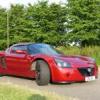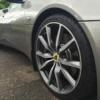Disclaimer - This guide is aimed at those with some mechanical experience but is easy enough to be followed by all. If you mess it up tho, don't shout at me.
After having a problem with loosing quite a bit of coolant and changing my expansion tank (to no avail) I realised that there was a problem with my radiator. Looking through the front grill I could see coolant had spilt into the crash limiter and there was a dark patch in one of the corners. Checking out the prices of new VXL radiators and the fact they have plastic ends, I decided to go for the eliseparts high pressure aluminium one.

You will need the following tools
8mm Socket
10mm Socket
Phillips no#2 screw driver
Flat head screw driver
2 Axel stands
Trolley Jack
Drill
Rivet Gun
8 x 4mm rivets
Angle grinder (if like mine your bolts are rusted to hell)
While I had the front clam off I decided to change the rusted steel c clips and bolts for stainless ones. This is a list of what I bought.
M6 x 25 mm Stainless washers x 50
M6 x 16 mm Stainless Hex Bolts x 10
M5 x 16 mm Stainless Hex Bolts x 20
M5 x 25 mm Stainless Hex Bolts x 10
Hi pressure Elise Radiator
Stainless 5 mm C-Clips x 10
Stainless 6 mm C-Clips x 10
After removing the front clam using the excellent Clam removal guide by Steve Crisp (Cheers) my car looked a bit like this

Step 1.
To make radiator removal a bit easier I decided to remove the bonnet and part of the under tray. To remove the bonnet leave it closed (but not locked) and undo the six front bolts, four on the inside and two on the outside with the 10mm socket.

Once all six screws have been removed, take the weight of the bonnet and open it up. once open slide the bonnet towards the windscreen and put it somewhere safe.
To remove the front part of the undertray it is easier to access jacked up. I jacked up either side of the car and placed an axel stand with a piece of wood under the jacking points.

The under tray is clipped into part of the chassis and is removed by undoing 5 retaining bolts with an 8mm socket (3 in the centre and one either side)
Step 2.
The next thing was to remove the radiator housing. There are four main bolts that secure the radiator to the housing (red circled in the photo), remove these with 10mm socket.

10 screws hold the radiator housing to the car body. Three at the front, three at the rear and two on either side. This picture shows the front three. Remove them with the Phillips Screw driver (or if they are rusted like mine drill off the heads)

This next picture shows the three rear screws. Note the right hand screw is obstructed by the abs unit and I couldn’t get it out from the rear. While unscrewing the radiator it is best to unplug the cooling fan which is the blue plug near the left hand screw, simply press and pull apart.

Circled in the next photo is one of the screws on the drivers’ side. To remove It, the head is on the underside of the car. With the under tray off it makes it much easier to access. Remove this one and the other on the passenger side.

A little further forward is the last screw to remove. It is circled in the following picture. Once again the screw must be removed from the underside of the car (one on each side).

The screws and clips that VXL use on the car are made of very weak steel which rusts and would not come out. To get them out I drilled out the heads and prised out the rusted C-clips.
Step 3.
Once all ten screws have been removed the radiator is ready to be drained. I had new coolant to replace what was in the system so I drained it into a plastic bowl by taking off the passenger side end radiator hose (the one with the bleed valve). There is a jubliee clip inside the housing that secures the hose, this is removed using a flat head screw driver.

The flow of coolant ran down the radiator housing and into the bowl. Remember to unscrew the expansion tank cap to release all the fluid (you may want to do it in stages because when the cap is open the coolant will flow very quickly).
The thread on the three rear screws on the housing shredded when I was trying to remove them. Because of the limited access space I could not get a drill in to remove the heads. The radiator can still be removed without removing the rear screws.
Step 4.
To remove the unit I disconnected the other side of the radiator (loosen jubilee clip and pull off feed hose), lifted the front of the radiator housing up and slid out the old radiator, feeding the electrical plug from the fan through the housing to remove it completely. I then drained out any remaining coolant.
When the radiator was out I took an angle grinder to the inside of the 3 rear screws and C-clips to remove them. I then replaced all 10 C-clips with the 5mm stainless ones I bought.
Edited by SteveA, 10 January 2007 - 12:35 AM.

























